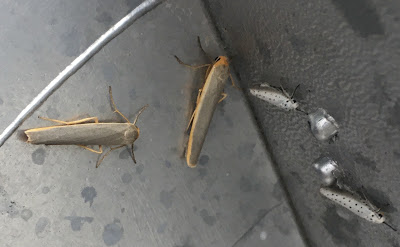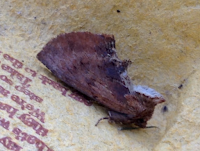An unusual sight met me just after I opened the moth trap yesterday morning - this initially unrecognisable visitor preparing for take-off. It took me a while to realise that it was a Coxcomb Prominent, which you almost always see in its resting position, as in the picture from a 2013 post on the left, with its wings tightly folded on either side of its back and its noble head in a coxcomb pose.
The grandchildren have been here and so we have had a spate of moth-on-my-finger-please-Grandpa exercises. Here is a Common Carpet doing its stuff:
And here's a Common or Lesser Common Rustic - actually, as you can see from their battered condition, the fingers in these cases are my own.
The two types of Rustic are impossible to tell apart without genital examination or even dissection which isn't my line, but I enjoy their many variations. Here's a darker one, below:
The Footmen moths are very prevalent at the moment, along with the various form of Ermine, as per recent posts. Here are my main types of visitor from each tribe:
 |
| Dingy Footman ab stramineola |
The poplar Hawk is meanwhile continuing its very long Summer season along with Elephant Hawks whose luscious pink and olive green brighten up the eggboxes from time to time. And the number and variety of other moths continues to be rich. Here are some of them:
 |
| Cloaked Minor |
 |
| Endotricha flammealis, showing its pink better than the picture in my last post |
 |
| Clouded Border |
 |
| Fan-foot |
 |
| Bird-cherry Ermine |
 |
| Willow Ermine |
 |
| Scarce Footmen pal up with a Willow and a Bird-cherry Ermine |
Finally, I was hunting around in a field of long grass for some conker trees which a group of us 'guerrilla-planted' earlier this year, when my eye was caught by a movement in the grass. I thought at first that it was a mouse of vole but all the commotion was caused by this Rosel's Bush Cricket with its distinctive curly 'horns'. It's quite an impressive jumper!









No comments:
Post a Comment